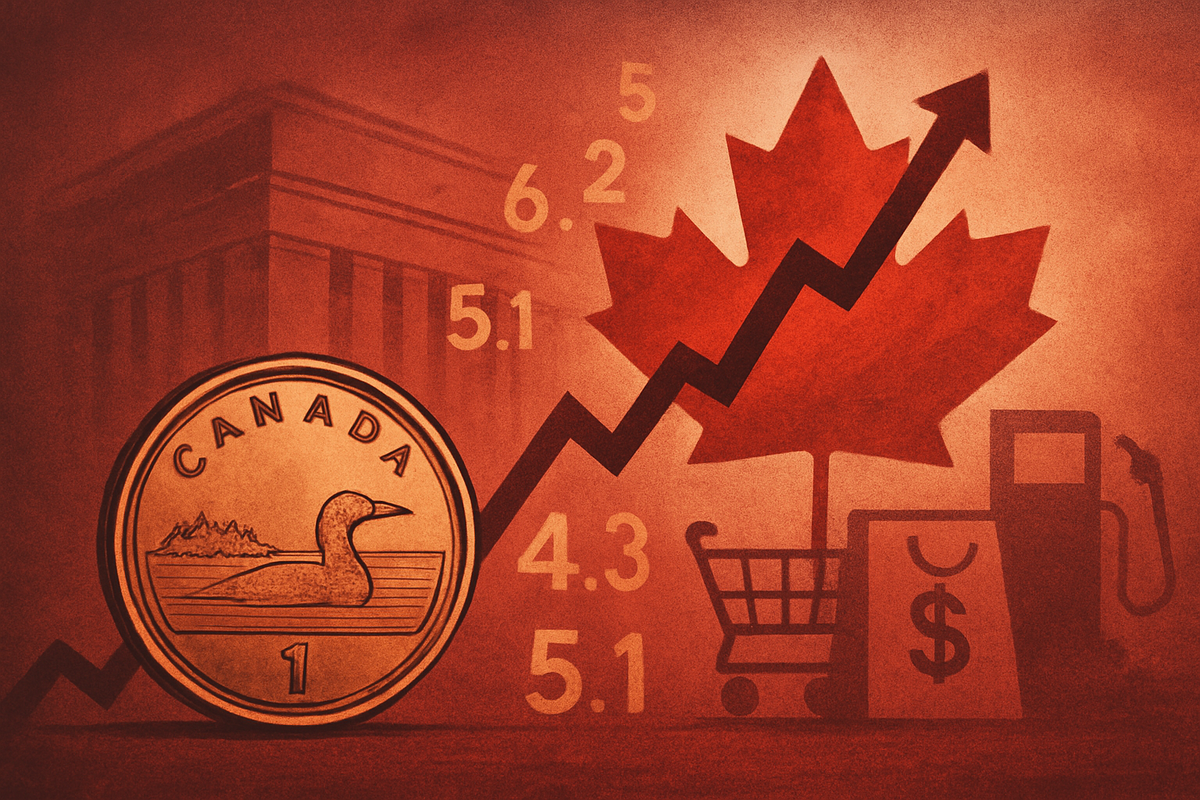Financial News
Canada's Inflation Edges Up to 2.4% in October 2025, Prompting BoC Scrutiny

Canada's annual inflation rate climbed to 2.4% in October 2025, a development that has immediately captured the attention of economists, policymakers, and market participants alike. This uptick places inflation firmly above the Bank of Canada's (BoC) 2% target midpoint, though still within its broader 1% to 3% control range. The latest data signals persistent price pressures within the Canadian economy, raising questions about consumer purchasing power, business operating costs, and the future trajectory of the Loonie (CAD). More critically, it puts the Bank of Canada in a challenging position, potentially forcing a reassessment of its monetary policy path and reigniting debates about interest rate adjustments.
Canada's Inflationary Pressures Mount: A Deeper Dive into the 2.4% Climb
The reported climb of Canada's annual inflation rate to 2.4% in October 2025 marks a significant moment for the nation's economic landscape. This figure, released by Statistics Canada, the federal agency responsible for compiling and disseminating the country's economic data, indicates a persistent upward trend in the cost of living. While the official Consumer Price Index (CPI) report for October 2025 is typically released in mid-November, the anticipation and analysis of such a figure on October 31, 2025, immediately trigger widespread discussion among economists and market participants.
Several factors are believed to be contributing to this inflationary pressure. Energy prices, particularly global oil and gas benchmarks, have shown volatility, directly impacting transportation and utility costs for households and businesses. Food prices have also remained elevated, driven by a combination of supply chain disruptions, adverse weather conditions affecting agricultural yields, and increased input costs for producers. Furthermore, Canada's robust housing market continues to exert upward pressure, with rising mortgage interest costs and rents forming a substantial component of the CPI basket. Strong consumer demand, fueled by a relatively tight labor market, may also be playing a role, allowing businesses to pass on higher operating costs to consumers.
The Bank of Canada (BoC), the country's central bank, is a key stakeholder in this scenario. With a primary mandate to keep inflation at the 2% midpoint of its 1% to 3% control range, the BoC meticulously scrutinizes such data. An inflation rate of 2.4% suggests that while still within the acceptable range, price pressures are leaning towards the upper bound, potentially requiring a more vigilant monetary policy stance. Initial market reactions to this inflation figure would likely include a strengthening of the Canadian dollar (CAD) as investors anticipate potential interest rate hikes or a prolonged period of higher rates from the BoC, aiming to cool the economy and bring inflation back to target. Bond yields would also likely see an uptick, reflecting increased expectations for future interest rates.
Economists and industry analysts are now dissecting the components of the CPI to understand whether the inflation is broad-based or concentrated in specific sectors. This detailed analysis will be crucial for forecasting future trends and advising on appropriate policy responses. The BoC, in its upcoming policy meetings, will undoubtedly weigh this data heavily against other economic indicators to determine its next steps, which could range from maintaining the current interest rate to considering further tightening measures if inflationary pressures are deemed persistent and widespread.
Corporate Fortunes in Flux: Winners and Losers Amidst Inflation and Dovish Monetary Policy
The latest inflation figures for October 2025, reaching 2.4%, arrive at a complex juncture for Canadian public companies, particularly in light of the Bank of Canada's (BoC) recent moves to cut interest rates. While an uptick in inflation might typically signal tighter monetary policy, the BoC has, in recent months, prioritized addressing weak economic growth and a struggling labor market. This creates a nuanced environment where some sectors may find unexpected challenges, while others could demonstrate resilience or even thrive.
The banking sector faces a challenging outlook. Despite lower interest rates typically stimulating loan demand, the BoC's rate cuts were driven by concerns over broader economic weakness and high consumer debt. This environment can pressure Net Interest Margins (NIMs) for institutions like Royal Bank of Canada (TSX: RY), Toronto-Dominion Bank (TSX: TD), Bank of Nova Scotia (TSX: BNS), Bank of Montreal (TSX: BMO), Canadian Imperial Bank of Commerce (TSX: CM), and National Bank of Canada (TSX: NA). While lower borrowing costs could eventually spur activity, the immediate concern is the potential for increased loan defaults if economic conditions don't improve and the real value of debt is eroded by inflation.
In the retail sector, the 2.4% inflation rate, particularly if driven by essential goods, will continue to erode consumer purchasing power. This puts pressure on companies selling discretionary items. High-end fashion retailers like Aritzia (TSX: ATZ) and luxury apparel brands such as Canada Goose (TSX: GOOS) could see reduced demand as consumers tighten their belts. Conversely, discount retailers and those focusing on consumer staples are likely to fare better. Companies like Loblaw Companies Limited (TSX: L), Alimentation Couche-Tard (TSX: ATD.B), Dollarama (TSX: DOL), and Metro Inc. (TSX: MRU) are well-positioned as consumers prioritize value and essential purchases in an inflationary environment.
The energy sector presents a mixed picture. While energy prices themselves can be a driver of inflation, the BoC's dovish stance, aimed at stimulating a weaker economy, could temper overall demand for commodities. However, a potentially weaker Canadian dollar, a possible consequence of rate cuts relative to other major currencies, could boost the value of U.S. dollar-denominated export revenues for producers. Major players such as Suncor Energy Inc. (TSX: SU) and Canadian Natural Resources (TSX: CNQ) might see benefits from a depreciating CAD, while midstream companies like Enbridge Inc. (TSX: ENB) and TC Energy Corporation (TSX: TRP) may offer more stability due to their infrastructure-based revenue streams.
The real estate sector remains a focal point of concern. Despite rate cuts aimed at alleviating borrowing costs, persistent affordability challenges, high household debt, and a softening labor market (with unemployment at 7.1%) continue to weigh heavily. Residential developers and REITs, such as Dream Office REIT (TSX: D.UN) for commercial properties, or residential-focused REITs like Boardwalk REIT (TSX: BEI.UN) and Minto Apartment REIT (TSX: MI.UN), could face headwinds from reduced demand or tenant affordability issues. However, certain sub-sectors, particularly industrial properties represented by Granite Real Estate (TSX: GRT.UN), may prove more resilient due to ongoing demand for logistics and e-commerce infrastructure. Diversified real estate services companies like Colliers International Group Inc. (TSX: CIGI), with global operations, might also be less directly exposed to the immediate pressures of the Canadian market.
A Delicate Balance: Inflation's Wider Significance in a Softening Economy
The climb of Canada's inflation rate to 2.4% in October 2025 carries profound wider significance, especially when viewed against the backdrop of the Bank of Canada's (BoC) recent aggressive monetary easing. This development thrusts the Canadian economy into a delicate balancing act, challenging the central bank's strategy and reverberating across various sectors, both domestically and internationally.
This inflationary uptick directly contradicts the BoC's recent trajectory of rate cuts, which saw the overnight rate reduced from a peak of 5% in spring 2024 to 2.25% following a 25-basis-point cut on October 29, 2025. These cuts were primarily aimed at stimulating a weakening economy, addressing a softening labor market (with unemployment at 7.1%), and mitigating the impacts of ongoing trade uncertainty, particularly with the United States. The 2.4% inflation figure, therefore, presents a significant monetary policy dilemma: how to support a fragile economy while simultaneously reining in persistent price pressures that now exceed the BoC's 2% target midpoint for the first time in six months. Underlying inflation measures, such as core inflation, also remain sticky around 2.5% to 3%, suggesting the pressures are not merely transitory.
The broader industry trends influencing this situation are complex. The Canadian economy continues to grapple with the lingering effects of the US trade war, which has led to weakened exports, dampened business investment, and increased operational costs due to tariffs. This has forced a "re-orientation of global trade" for Canadian firms. Despite the BoC's efforts, GDP growth remains weak, with a contraction in Q2 2025 and forecasts for continued below-trend growth. This confluence of weak growth and rising inflation raises concerns about a potential "stagflationary" environment, where economic stagnation coexists with high inflation.
Ripple effects are evident across the economy. Canadian businesses face the dual challenge of higher input costs from inflation and potentially reduced consumer demand if real wages continue to erode. For international partners, particularly the United States, diverging economic trends and monetary policies could lead to increased volatility in the Canada-US exchange rate. If Canadian inflation remains elevated while the US Federal Reserve maintains a tighter stance, the Canadian dollar could face further pressure. This also underscores a growing recognition that monetary policy alone cannot address structural economic damage, prompting calls for more targeted fiscal policies from the Canadian government to support affected sectors.
Historically, Canada has faced similar inflationary battles. The severe inflation of the 1980s and early 1990s, with CPI reaching over 13% and 7% respectively, saw the BoC implement aggressive rate hikes (over 20% in 1981) to bring prices under control, albeit at the cost of significant economic slowdowns. More recently, the post-pandemic inflation surge (2021-2023), peaking at over 8% in June 2022, prompted the BoC's most rapid tightening cycle, raising rates to 5%. While the current 2.4% is far from these highs, it serves as a stark reminder of inflation's persistent nature and the BoC's commitment to its mandate, even when faced with a weakening economy. This history suggests the BoC will be extremely cautious about letting inflation become entrenched, despite its current dovish posture.
Navigating the Crossroads: What Comes Next for Canada
The unexpected climb of Canada's inflation rate to 2.4% in October 2025, juxtaposed with the Bank of Canada's (BoC) recent policy of rate cuts, places the nation at a critical economic crossroads. The path forward for the Canadian economy, the value of the Loonie (CAD), and the BoC's monetary policy will be shaped by how these conflicting forces resolve.
In the short term, the Canadian economy is expected to continue navigating a period of modest growth and persistent challenges. The labor market is likely to remain soft, particularly in sectors vulnerable to ongoing US tariffs. Affordability issues, especially in the housing market, will continue to constrain consumer spending. The BoC has signaled that its current policy rate of 2.25%, achieved after the October 29th cut, is "about the right level" if inflation and economic activity evolve as projected, suggesting a potential pause in further rate reductions. However, this stance will be heavily data-dependent, with future decisions hinging on incoming inflation and employment figures.
Looking further ahead, the long-term outlook suggests a lower growth trajectory for Canada, as the structural damage from trade conflicts reduces productive capacity. The BoC forecasts GDP growth of 1.2% in 2025, gradually strengthening into 2026 and 2027, but acknowledges the risk of a "stagflationary" scenario where weak growth coexists with elevated inflation. For the Loonie, the short-term reaction to the BoC's recent rate cuts saw an initial dip followed by some resilience, indicating market expectations for a potential end to the easing cycle. However, the currency remains vulnerable to ongoing US trade policy developments and any significant divergence in monetary policy between the BoC and the US Federal Reserve. A sustained weaker Loonie could, in turn, exacerbate inflationary pressures by making imports more expensive.
Market opportunities and challenges will be pronounced. The real estate sector, particularly the pre-construction condo market, continues to face significant challenges due to affordability issues, despite lower borrowing costs. Sectors like consumer staples and discount retail, which tend to perform well when consumers are value-conscious, may present opportunities. Conversely, discretionary spending retailers could face headwinds. Investors should brace for continued market volatility and remain highly responsive to incoming economic data. Potential strategic pivots for the BoC could include an extended pause in rate cuts, or, in a more hawkish scenario, a dramatic shift towards rate hikes if inflation re-accelerates rapidly and is perceived as demand-driven. Conversely, a more significant and prolonged economic downturn could still compel the BoC to resume rate cuts in early 2026. This complex interplay of forces will necessitate agility from businesses and investors alike.
A Nation at a Crossroads: Final Thoughts on Canada's Inflationary Challenge
Canada's inflation rate climbing to 2.4% in October 2025 marks a pivotal moment, signaling persistent price pressures that directly challenge the Bank of Canada's (BoC) recent dovish monetary policy. The key takeaway is the emergence of a complex economic environment where the BoC is attempting to stimulate a weak economy and a soft labor market through interest rate cuts, even as inflation pushes above its 2% target midpoint. This creates a delicate balancing act, raising concerns about potential stagflation and the effectiveness of monetary policy alone to address deep-seated structural issues, particularly those stemming from ongoing trade tensions.
Moving forward, the market will be closely scrutinizing every piece of economic data, especially subsequent inflation reports and labor market statistics. The BoC's communication will be paramount as it navigates this contradictory landscape. While the central bank has indicated its current policy rate of 2.25% is "about the right level," the unexpected rise in inflation to 2.4% could test this resolve. Investors should anticipate continued volatility, with the Canadian dollar's trajectory heavily influenced by both domestic economic data and the monetary policy divergence with the US Federal Reserve.
The lasting impact of this period could be a re-evaluation of Canada's economic resilience in the face of external shocks and internal structural challenges. Businesses may need to adapt to a prolonged period of higher operating costs, while consumers will continue to grapple with eroded purchasing power. The significance lies in the BoC's dilemma: whether to prioritize inflation control, potentially at the expense of economic growth, or to continue supporting growth, risking further inflationary pressures. This scenario underscores the increasing importance of coordinated fiscal policy to complement monetary efforts in addressing the nation's economic vulnerabilities.
Investors in the coming months should watch for signs of sustained inflation in core measures, the BoC's rhetoric and any shifts in its forward guidance, and the evolution of the labor market. Furthermore, global commodity prices and developments in international trade relations, particularly with the US, will continue to play a crucial role in shaping Canada's economic destiny. The coming quarters will be a true test of Canada's ability to maintain price stability while fostering sustainable growth in an increasingly uncertain global environment.
This content is intended for informational purposes only and is not financial advice
More News
View More




Recent Quotes
View More
Quotes delayed at least 20 minutes.
By accessing this page, you agree to the Privacy Policy and Terms Of Service.



